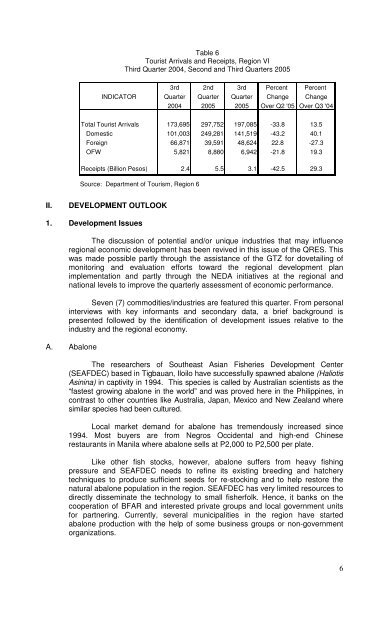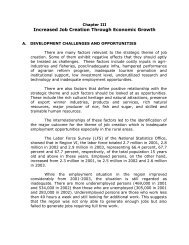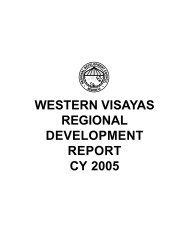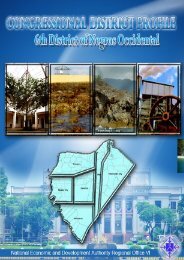REGIONAL ECONOMIC SITUATIONER Western ... - NEDA-RDC VI
REGIONAL ECONOMIC SITUATIONER Western ... - NEDA-RDC VI
REGIONAL ECONOMIC SITUATIONER Western ... - NEDA-RDC VI
Create successful ePaper yourself
Turn your PDF publications into a flip-book with our unique Google optimized e-Paper software.
Table 6<br />
Tourist Arrivals and Receipts, Region <strong>VI</strong><br />
Third Quarter 2004, Second and Third Quarters 2005<br />
3rd 2nd 3rd Percent Percent<br />
INDICATOR Quarter Quarter Quarter Change Change<br />
2004 2005 2005 Over Q2 '05 Over Q3 '04<br />
Total Tourist Arrivals 173,695 297,752 197,085 -33.8 13.5<br />
Domestic 101,003 249,281 141,519 -43.2 40.1<br />
Foreign 66,871 39,591 48,624 22.8 -27.3<br />
OFW 5,821 8,880 6,942 -21.8 19.3<br />
Receipts (Billion Pesos) 2.4 5.5 3.1 -42.5 29.3<br />
Source: Department of Tourism, Region 6<br />
II. DEVELOPMENT OUTLOOK<br />
1. Development Issues<br />
The discussion of potential and/or unique industries that may influence<br />
regional economic development has been revived in this issue of the QRES. This<br />
was made possible partly through the assistance of the GTZ for dovetailing of<br />
monitoring and evaluation efforts toward the regional development plan<br />
implementation and partly through the <strong>NEDA</strong> initiatives at the regional and<br />
national levels to improve the quarterly assessment of economic performance.<br />
Seven (7) commodities/industries are featured this quarter. From personal<br />
interviews with key informants and secondary data, a brief background is<br />
presented followed by the identification of development issues relative to the<br />
industry and the regional economy.<br />
A. Abalone<br />
The researchers of Southeast Asian Fisheries Development Center<br />
(SEAFDEC) based in Tigbauan, Iloilo have successfully spawned abalone (Haliotis<br />
Asinina) in captivity in 1994. This species is called by Australian scientists as the<br />
“fastest growing abalone in the world” and was proved here in the Philippines, in<br />
contrast to other countries like Australia, Japan, Mexico and New Zealand where<br />
similar species had been cultured.<br />
Local market demand for abalone has tremendously increased since<br />
1994. Most buyers are from Negros Occidental and high-end Chinese<br />
restaurants in Manila where abalone sells at P2,000 to P2,500 per plate.<br />
Like other fish stocks, however, abalone suffers from heavy fishing<br />
pressure and SEAFDEC needs to refine its existing breeding and hatchery<br />
techniques to produce sufficient seeds for re-stocking and to help restore the<br />
natural abalone population in the region. SEAFDEC has very limited resources to<br />
directly disseminate the technology to small fisherfolk. Hence, it banks on the<br />
cooperation of BFAR and interested private groups and local government units<br />
for partnering. Currently, several municipalities in the region have started<br />
abalone production with the help of some business groups or non-government<br />
organizations.<br />
6








